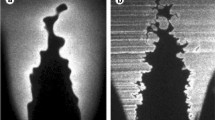Abstract
The majority of computational studies of confined explosion hazards apply simple and inaccurate combustion models, requiring adhoc corrections to obtain realistic flame shapes and often predicting an order of magnitude error in the overpressures. This work describes the application of a laminar flamelet model to a series of two-dimensional test cases. The model is computationally efficient applying an algebraic expression to calculate the flame surface area, an empirical correlation for the laminar flame speed and a novel unstructured, solution adaptive numerical grid system which allows important features of the solution to be resolved close to the flame. Accurate flame shapes are predicted, the correct burning rate is predicted near the walls, and an improvement in the predicted overpressures is obtained. However, in these fully turbulent calculations the overpressures are still too high and the flame arrival times too low, indicating the need for a model for the early laminar burning phase. Due to the computational expense, it is unrealistic to model a laminar flame in the complex geometries involved and therefore a pragmatic approach is employed which constrains the flame to propagate at the laminar flame speed. Transition to turbulent burning occurs at a specified turbulent Reynolds number. With the laminar phase model included, the predicted flame arrival times increase significantly, but are still too low. However, this has no significant effect on the overpressures, which are predicted accurately for a baffled channel test case where rapid transition occurs once the flame reaches the first pair of baffles. In a channel with obstacles on the centreline, transition is more gradual and the accuracy of the predicted overpressures is reduced. However, although the accuracy is still less than desirable in some cases, it is much better than the order of magnitude error previously expected.
Similar content being viewed by others
References
Popat, N.R., Catlin, C.A., Arntzen, B.J., Lindstedt, R.P., Hjertager, B.H., Solberg, T., Saeter, O. and Van den Berg, A.V., Investigations to improve and assess the accuracy of computational fluid dynamic based explosion models. J. Haz. Mat. 45 (1996) 1-25.
Savill, A.M. and Solberg, T., Some improvements to PDR/k-ε model predictions for explosions in confined geometries. In: Perkins, R.J. and Belchor, S.E. (eds), Proceedings of the IMA/ERCOFTAC Conference on Flow and Dispersion Through Groups of Obstacles. IMA Conference Series 62 (1994) pp. 227-249.
Hjertager, B.H., Solberg, T. and Nymoen, K.O., Computer modelling of gas explosion propagation in offshore modules. J. Loss. Prev. 5 (1991) 165-174.
Hjertager, B.H., Simulation of transient compressible turbulent reactive flows. Combust. Sci. Tech. 27 (1982) 159-170.
Pritchard, D.K., Freeman, D.J. and Guilbert, P.W., Prediction of explosion pressure in confined spaces. J. Loss. Prev. 9 (1996) 205-215.
Catlin, C.A. and Lindstedt, R.P., Premixed turbulent burning velocities derived from mixing controlled models with cold flow quenching. Combust. Flame 85 (1991) 427-439.
Bray, K.N.C., Studies of the turbulent burning velocity. Proc. Roy. Soc. London Ser. A 431 (1990) 315-335.
Catlin, C.A., Fairweather, M. and Ibrahim, S.S., Predictions of turbulent, premixed flame propagation in explosion tubes. Combust. Flame 102 (1995) 115-128.
Bray, K.N.C., Libby, P.A. and Moss, J.B., Unified modelling approach for premixed turbulent combustion — Part 1: General formulations. Combust. Flame 61 (1985) 87-102.
Cant, R.S. and Bray, K.N.C., Strained laminar flamelet calculations of premixed turbulent combustion in a closed vessel. In: Twenty-Second Symposium (International) on Combustion. The Combustion Institute, Pittsburgh, PA (1988) pp. 791-799.
Rogg, B., The response and flamelet structure of stretched laminar premixed methane air flames. Combust. Flame 73 (1988) 45-65.
Watterson, J.K., Connell, I.J., Savill, A.M. and Dawes, W.N., A solution-adaptive mesh procedure for predicting confined explosions. Internat. J. Numer. Methods Fluids 26 (1998) 235-247.
Dawes, W.N., The practical application of solution-adaption to the numerical solution of complex turbomachinery problems. Prog. Aerospace Sci. 29 (1993) 221-269.
Jameson, A. and Baker, T.J., Improvements to the aircraft Euler method. AIAA Paper 87-0452 (1987).
Lam, C.K.G. and Bremhorst, K., Modified form of the k-ε model for predicting wall turbulence. J. Fluids Engrg. 103 (1981) 456-460.
Jameson, A. and Baker, T.J., Multigrid solution of the Euler equations for aircraft configurations. AIAA Paper 84-0093 (1984).
Cant, R.S. and Bray, K.N.C., A theoretical model of premixed turbulent combustion in closed vessels. Combust. Flame 76 (1989) 243-263.
Cant, R.S., Pope, S.B. and Bray, K.N.C., Modelling of flamelet surface-to-volume ratio in turbulent premixed combustion. In: Twenty-Third Symposium (International) on Combustion. The Combustion Institute, Pittsburgh, PA (1990) pp. 809-815.
Bray K.N.C., Libby, P.A. and Moss, J.B., Flamelet crossing frequencies and mean reaction rates in premixed turbulent combustion. Combust. Sci. Tech. 44 (1984) 143-172.
Watkins, A.P., Li, S.-P. and Cant, R.S., Premixed combustion modelling for spark-ignition engine applications. SAE Paper No. 961190 (1996).
Abu-Orf, G.M., Laminar flamelet reaction rate modelling for spark-ignition engines. Ph.D. Thesis, University of Manchester Institute of Science and Technology, U.K. (1996).
Abdel-Gayed, R.G., Al-Khishali, K.J. and Bradley, D., Turbulent burning velocities and flame straining in explosions. Proc. Roy. Soc. London Ser. A 391 (1984) 393-414.
Freeman, D.J., Visualisation of explosions in baffled plate, vented enclosure. HSE Project Report No. IR/GE/94/08 (1994).
Freeman, D.J., Experimental validation of methods for predicting explosion pressures in confined spaces: summary of results obtained for a baffled, vented enclosure. HSE Project Report No. IR/L/GE/94/03 (1994).
Author information
Authors and Affiliations
Rights and permissions
About this article
Cite this article
Birkby, P., Cant, R. & Savill, A. The Application of a Laminar Flamelet Model to Confined Explosion Hazards. Flow, Turbulence and Combustion 63, 361–377 (2000). https://doi.org/10.1023/A:1009932203310
Issue Date:
DOI: https://doi.org/10.1023/A:1009932203310




